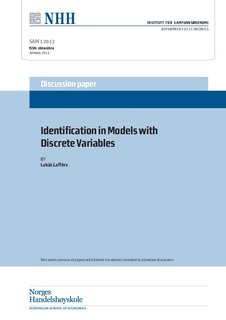| dc.contributor.author | Lafférs, Lukáš | |
| dc.date.accessioned | 2013-03-14T12:03:40Z | |
| dc.date.available | 2013-03-14T12:03:40Z | |
| dc.date.issued | 2013-01 | |
| dc.identifier.issn | 0804-6824 | |
| dc.identifier.uri | http://hdl.handle.net/11250/163090 | |
| dc.description.abstract | This paper provides a new simple and computationally tractable method for
determining an identified set that can account for a broad set of economic models
when economic variables are discrete. Using this method it is shown on a simple
example how can imperfect instruments affect the size of the identified set when
strict exogeneity is relaxed. It could be of great interest to know to what extent are
the results driven by the exogeneity assumption which is often a subject of controversy.
Moreover, flexibility gained from the new proposed method suggests that
the determination of the identified set need not be application-specific anymore.
This paper presents a unifying framework that approaches identification in an
algorithmic way. | no_NO |
| dc.language.iso | eng | no_NO |
| dc.publisher | Norwegian School of Economics, Department of Economics | no_NO |
| dc.relation.ispartofseries | Discussion paper;1/2013 | |
| dc.title | Identification in models with discrete variables | no_NO |
| dc.type | Working paper | no_NO |
| dc.subject.nsi | VDP::Social science: 200::Economics: 210::Economics: 212 | no_NO |
